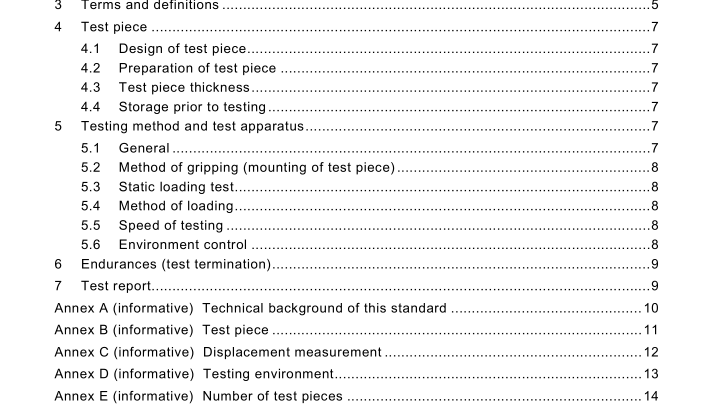IEC 62047-6-2009 pdf download – Semiconductor devices – Micro-electromechanical devices – Part 6: Axial fatigue testing methods of thin film materials
4 Test piece
4.1 Design of test piece In order to minimize the influence of size, the test piece should have dimensions of the same order as that of the objective device component. The shape and dimensions of the specimen should be based on Annex C of IEC 62047-2. The dimensions of the plane shape of the specimen shall be within an accuracy range of ± 1 % as specified in IEC 62047-2. The length of the parallel part of the test piece shall be more than 2,5 times the width. See C.1 in IEC 62047-2. The curved part between the gripped ends and the parallel part should have a radius of curvature sufficient to not cause a fracture at the curved part due to stress concentration. See C.2 in IEC 62047-2. The gauge marks specified in IEC 62047-2 are not necessary if the marks may concentrate stress or initiate fatigue fractures.
4.2 Preparation of test piece The test piece should be fabricated using a process as similar as possible to that of the device to which the thin film is to be applied. The test piece also should be fabricated following the procedures specified in IEC 62047-2. The substrate removal process should be carefully chosen to prevent damaging the test piece. See C.3 in IEC 62047-2. The number of test pieces should be determined adequately according to the thin films tested. See Annex E.
4.3 Test piece thickness The thickness of each test piece shall be measured, as the film thickness is not usually uniform over a wafer. The accuracy of the measurement shall be within 5 %. Each test piece should be measured directly. However, the film thickness at the step height of a window opening etched near the test piece can be used as the thickness of a specimen in order to avoid mechanical damage from the use of a stylus profiler, etc. Methods of measuring film thickness and measurement errors are given in C.4 of IEC 62047-2.
4.4 Storage prior to testing In the case of thin films, the storage environment may affect the fatigue properties. If there is an interval between final preparation and testing, particular care should be taken in storing the test pieces, and the specimens should be examined by appropriate means to ensure that the surface has not deteriorated during the storage period. If any deterioration is observed that was not present after the specimens were prepared, testing shall not be performed. However, if the damage was introduced during the preparation processes, the test shall be performed.
5 Testing method and test apparatus
5.1 General The testing machine should be equipped with a gripping mechanism appropriate for the test piece, as well as with a mechanism for applying cyclic loading. The cyclic loading applied to the test piece should be basically tensile-tensile mode loading. For constant range force testing, maximum and minimum forces (or mean force and force range) shall be monitored and the testing machine should be equipped with a constant force range control system. For constant displacement range testing, the maximum and minimum displacements (or mean displacement and displacement range) shall be monitored and the testing machine should be equipped with a constant displacement range control system. A test-piece failure detection system should be provided and the number of loading (or displacement) cycles to failure shall be recorded.
5.2 Method of gripping (mounting of test piece) Each test piece shall be mounted so that the loading axis and test piece axis are aligned. When gripping both ends of the test piece, care shall be taken to avoid applying excess force and/or bending stress to the test piece. The gripping methods indicated in Annex A of IEC 62047-2 are recommended for mounting the test pieces. In addition, the testing apparatus should be equipped with a test piece alignment mechanism to ensure that the tensile axis of the test piece is aligned with the loading direction of the test apparatus.
